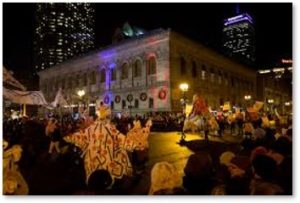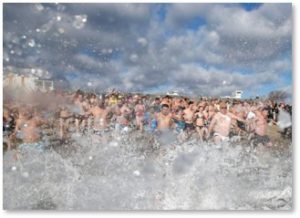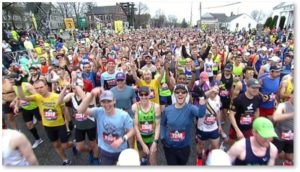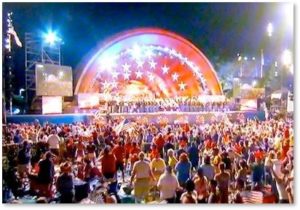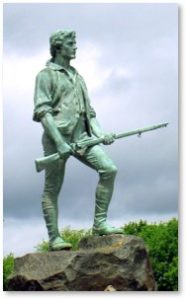People visit Boston for a lot of reasons but history is a big one. They want to see and teach their children about Boston’s role in the founding of our country. That means these tourists see the city in terms of the past and think of it as either old-fashioned or frozen in time. I have actually had guests on a tour who were surprised that Boston didn’t look more like Colonial Williamsburg—an historical artifact—than a vibrant 21st-century city.
Boston’s Five First Events
In reality, Boston has always been an innovative city. Our citizens created many events for the first time that broke new ground and set new examples. Many were later replicated by other cities. Here are Boston’s five first events.
-
First Night (December 31)
Back in the fifties and sixties, one celebrated New Year’s Eve by going to a restaurant or a bar and often drinking too much before ushering in a tipsy New Year. Restaurants ran big newspaper ads encouraging you to make your reservations early. The unspoken message was that if you didn’t come and join the revels, you would be left out in the cold.
People had parties, of course, but there were no big citywide celebrations that included artworks, performances, parades, ice sculptures, music, dancing in the streets and fireworks.
Then Gloucester artist Clara Wainwright created Boston’s First Night in 1975. She organized a small group of artists that wanted to find an alternative way of celebrating New Year’s Eve. The goal was to avoid an emphasis on alcohol and give Boston’s young, innovative artists and musicians the opportunity to perform on both indoor and outdoor stages. It was a huge success.
First Night Around the Country
Soon other communities began replicating Boston’s First Night on a smaller scale and then other cities around the country picked it up. At its height, about 260 cities had First Night celebrations on New Year’s Eve. Later, 20 cities dropped out due to financial or security concerns. Still, First Night has been a huge success, replacing drinking (and the subsequent drunk driving) with art, culture, and fun.
-
The Polar Bear Swim (January 1)
What better way to welcome the New Year than by putting on a swim suit and plunging into an ice-cold ocean? Okay, not everyone shares that feeling—including me—but lots of people do.
The L Street Brownies have been doing it for 116 years, since taking the first Polar Bear Swim in 1904. That’s 116 years of plunging into an icy ocean wearing nothing but a Speedo. This event is not a complete first; as it happened simultaneously with New York’s Coney Island Polar Bear Club.
Immigrants brought the icy plunge o the United States because they felt that winter swimming strengthens the immune system. They claimed that swimming and tanning were beneficial to the heart, skin, and circulation, and credited the practice with miraculous cures.
With or Without Speedos
Swimmers who came regularly to the L Street Bathhouse in South Boston became known as the “Brownies” because of the deep tans they acquired from daily exposure to the sun. They usually swam nude or with minimal clothing.
Now, each January 1, at least 12 cities have some hardy citizens participating in a Polar Bear Plunge. Here in Boston, hundreds of nearly naked swimmers line up, run down the beach into the water and dash back again. Some wear costumes, while others go with simple swim suits. This year, the air temperature in Boston was a toasty 42 degrees and the water temperate was 39 degrees. We might not have as many people in the plunge but that’s got to be colder than New York.
-
The Boston Marathon (April 19)
Every marathon runner knows the directions, “Right on Hereford, left on Boylston.” That takes them to the end of the Boston Marathon, the world’s oldest marathon race. Organized by the Boston Athletic Association, this 26.2-mile race takes place on the third Monday in April, which is Patriot’s Day in Boston. (No, not George W. Bush’s Patriot Day. That’s a recent invention and largely ignored.)This holiday, celebrated only in Maine and Massachusetts, commemorates the famous battles of Lexington and Concord.
The Boston Marathon, first run in 1897 by only 15 participants, was long seen as something only weird hyper athletes did. Not many runners participated. The race was inspired by the 1896 Olympic marathon and news outlets covered it for decades as a strange sport,something like running naked into the ocean on January 1.
Running Becomes A Thing
That all changed in the seventies when running became A Thing. Olympic runner Frank Shorter took gold in the 1972 Olympic men’s marathon—only the third American to do so. This, along with a greater awareness of the importance of physical fitness to good health, kicked off a national involvement with running.
The logical competitive step for non-Olympic athletes was to run races and the Boston Marathon was the only game in town. Now it is so popular that the BAA caps the number of runners at 32,500 and the race always runs at capacity.
Women have been in the race since 1972, when Kathy Switzer qualified using her initials to disguise her gender. It did not go well. You can see the video of the BAA’s race official,Jock Semple attacking her on the racecourse here.
The Boston Marathon attracts 500,000 spectators each year, making it New England’s most widely viewed sporting event. Now American cities sponsor over 713 marathon races and no one thinks running that far is weird any more. But “running Boston” is the highlight for many distance runners across the country. I once had a marathon runner from Finland on a Boston By Foot tour. He had come to the United States just to run Boston.
-
Esplanade Concerts (July 4)
Communities around the United States have celebrated Independence Day with music and fireworks for centuries. Not until 1929 did these include a major orchestra, however, and only in the seventies did Fourth of July concerts go big time.
Before he became conductor of the Boston Pops orchestra, violinist Arthur Fiedler raised funds to make great symphonic music available to “the masses.” He wanted people who could never buy a ticket to Symphony Hall to hear such music, the way they could visit an art museum to see great paintings. The first free Esplanade Concert by the Boston Pops orchestra was held on July 4, 1929.
The tradition continued in the specially constructed acoustic shell on the Esplanade, a public park along the banks of the Charles River. In 1974, businessman David Mugar ramped up these concerts into a major event. He collaborated with Mr. Fieldler, a long-time friend, to add cannons (actually howitzers) and fireworks to the concert’s grand finale—Tchaikovsky’s 1812 Overture. In 2017 the Pops organization presented its first self-produced Boston Pops Fireworks Spectacular.
A Mob on the Esplanade
In 1976, the special bicentennial concert attracted 400,000 people and made the Independence Day Esplanade concerts one of Boston’s major events. Every year, typically half a million people descend on the Esplanade with picnic hampers, coolers, blankets, and umbrellas to stake out a prime spot on the lawn and wait (and wait) for the evening’s music to begin.
Other cities took up the good idea brought to fruition by Messrs. Fiedler and Mugar and made it their own. Washington DC followed in 1979 with “A Capital Fourth” and New York City initiated “Liberty Weekend” in 1986 to commemorate the centenary and restoration of the Statue of Liberty. When it comes to the Fourth of July spectacular, though, it started in Boston.
-
America (1775)
Without Boston’s rowdy Sons of Liberty, the Revolutionary War might never have happened. We would be singing God Save the Queen instead of The Star-Spangled Banner.
The Boston Tea Party marked the turning point in colonists’ protests against the British government and there was no going back from there. But Captain John Parker. Leader of the Minute Men on Lexington Green on April 19, 1775 said it best:
“Stand your ground. Don’t fire unless fired upon, but if they mean to have a war let it begin here.”
They did. The rest is American history.
Boston’s Innovations
As you can see, Boston has long been in the forefront of innovative thinking, even when it hasn’t been popular. But new ideas often take a while to catch on. In the meantime, most people call them weird, strange, and over the top.
New York City may shout louder or spend more than Boston and Washington DC can always generate the country’s top news. Bostonians may seem quieter and more restrained by comparison but we have no problem having big ideas and trying new things. Boston’s five first events — the model for other cities and organizations — are among them.
